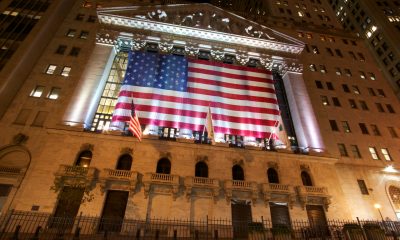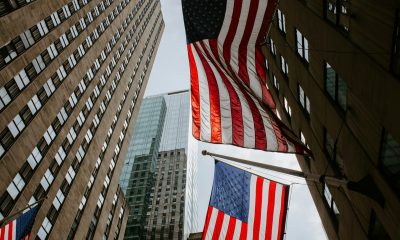Markets
Navigating the Fourth Turning: Cycles of Crisis and Opportunity
The Fourth Turning by Strauss and Howe outlines recurring 85-year historical cycles of societal change, each with four 20-year eras—High, Awakening, Unraveling, and Crisis. The current Crisis began in 2008. Similar to Kondratieff and other long-term cycles, it suggests rising upheaval. Amid inflation, geopolitical tensions, and tariffs, assets like gold and tech thrive during uncertainty.
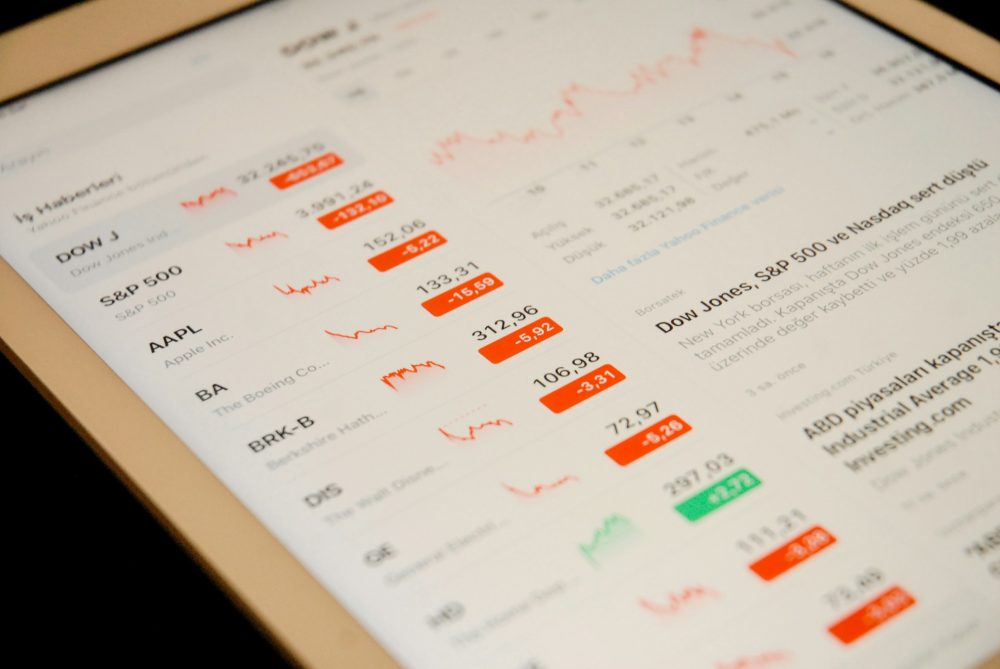
The Fourth Turning is a book written by William Strauss and Neil Howe that came out in 1997. The theory postulates that history runs in cycles of roughly 85 years, although the range could be 75–100 years. The book argues that each turning point, lasting about 20 years, shapes society and influences the actions of different generations. The fourth turning, a crisis period, is a time of societal upheaval and transformation, often marked by war or revolution.
The book details how each turning breaks down into four eras of roughly 21 years. Each era or turning has characteristics:
- High: a period of confident expansion and prosperity
- Awakening: a time of spiritual exploration and rebellion
- Unraveling: individualism triumphs over crumbling institutions
- Crisis: the most perilous turning point, a period of societal upheaval and transformation
Strauss and Howe believe our current cycle started in 1946, after the fourth turning of the previous era. It spanned roughly 1929–1946: the period of the Great Depression and World War II. Strauss and Howe believe our current cycle has been unfolding as follows:
- High: 1946–1964 (18 years). A period of expansion and growing prosperity. Korean War 1950–1953. The period was shattered with the assassination of John F. Kennedy in November 1963
- Awakening: 1964–1984 (20 years). The Woodstock generation, a period of spiritual exploration and rebellion. The Vietnam War. The period ended with the onset of the Reagan Revolution in the 1980s
- Unraveling: 1984–2008 (24 years). A period of rising individualism and loss of faith in institutions, with attacks on institutions, financial crises—i.e. Latin America debt crisis, Savings & Loan crisis—wars, i.e. the Iraq War, the Soviet Union collapse (1989), the tech boom (1990s), Russia’s collapse (1998), the dot.com/high-tech collapse, and 9/11 (2000–2002)
- Crisis: 2008–? The financial crisis of 2008, the Great Recession, EU/Greek debt crisis, the rise of societal polarization and inequality, the COVID19 pandemic, Trump, tariffs and trade wars, and upheaval in the U.S. Wars: Russia/Ukraine, Israel/Hamas, Israel/Iran. Afghanistan War came to an end. To come, the unravelling of the U.S., recession, world war?
What strikes us about Strauss and Howe’s theory is how closely it resembles the Kondratieff wave cycle. The Kondratieff wave is generally believed to be roughly 60 years, so it is not a perfect fit. Without going into details, the last Kondratieff wave lasted from 1949 to 2009: 60 years. The breakdown was as follows:
- Spring: 1949–1966, expansion, a period of rising prosperity, new technologies, rising stocks, weak commodities, Korean War
- Summer: 1966–1982, a period of high economic activity, rising inflation, recessions, strong commodities, weak stocks, Vietnam War
- Autumn: 1982–2000, A period of economic decline against the backdrop of a boom, rise of new technologies, rising stocks, weak commodities, Iraq War
- Winter: 2000–2009, a period of upheaval and recession, rise of new technologies, weak stocks, strong commodities, Iraq War, 9/11
- Spring: 2009–2020, a period of economic expansion against the backdrop of rising inequality and increasing polarization, rise of new technologies, rising stocks, weak commodities, Afghanistan War, Arab Spring
- Summer: 2020–? Upheaval, pandemic, rising tensions, polarization, inflation, recessions, strong commodities, weak stocks, Russia/Ukraine war, Israel/Hamas war, Israel/Iran war
We have also noted long-term cycles, as defined by Ray Merriman (www.mmacycles.com), of 72 years and 90 years. Calculating from the Great Depression low in 1932, the 72-year cycle last bottomed in 2009 (77 years) and the 90-year cycle low was due 2022 but has a range of 75–100 years. The 90-year cycle, quite similar to the Fourth Turning, has had few observations. Before 1932 and the Great Depression, the previous one was in 1843 at the height of the period known as the Hungry Forties.
Since the United States of America came into being in 1776, we have observed three fourth turnings. The period from roughly 1756–1799 could be described as a fourth turning, given it featured wars: the Seven Years’ War (1756–1763), the American Revolution (1776–1789), and the French Revolution (1789–1799). It was a period of upheaval, revolutions, wars, and economic depressions. The second fourth turning was the period from roughly 1856 to 1877, highlighted by the U.S. Civil War (1861–1865) and the Long Depression of the 1870s. The next one was, of course, the Great Depression and World War II that lasted roughly from 1929 to 1946.

Understanding where we are in the cycles is a potential key to investment success. Setting aside the rise of Bitcoin, we discover that once again the best-performing assets since 2020 have been gold, followed by the MAG7. Going back to 2008 we also discover that gold was close behind the S&P 500. We are in a period of upheaval with rising loss of faith in governments, rising geopolitical tensions, and economic uncertainty—perfect conditions for gold.
Inflation Rate
U.S. Inflation Rate, Core Rate, 10-year U.S. treasury, Fed Interest Rate 2015–2025
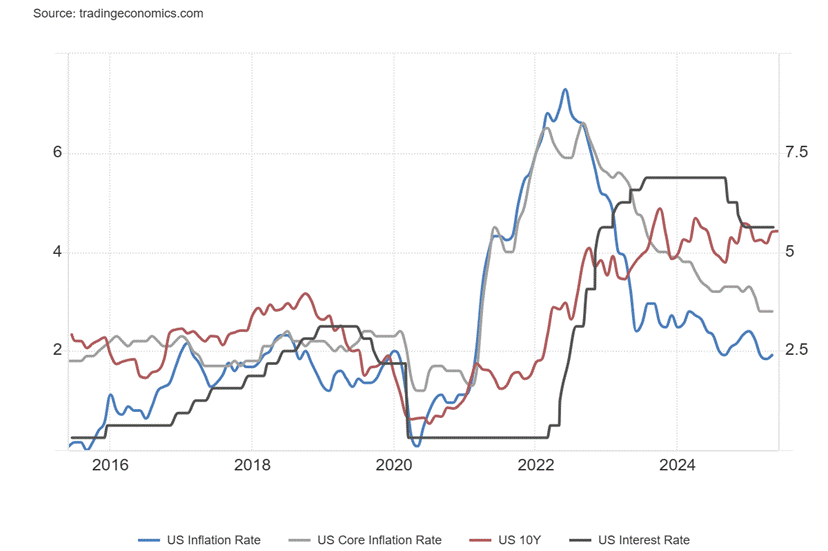
Where’s the beef? Everyone was expecting inflation to rise because of the tariffs. No such luck, so far. Okay, we did rise to 2.4% from 2.3% the previous month, but the expectation was a rise to 2.5%. It was a mixed bag of food prices, transportation services, cars and trucks rising while rent and energy fell. Even at that, core inflation (ex-food and energy) rose 2.8%, the same as April. The expectation for the core rate was 2.9%. All in all, a little softer than expected.
However, if we look at the Shadow Stats CPI, we discover they have last calculated the April CPI as up 10.5%. What Shadow Stats does is to go back to methodologies used in the 1980s before they started to adjust the CPI to consider cheaper products as a substitute or, as they call it, owner’s equivalent rent.
The rate for the 10-year U.S. Treasury note remains above the rate of inflation as is the Fed interest rate. A real interest rate has been the norm over the years. Except that, since the 2008 financial crisis, negative real interest rates have primarily been the norm. This, along with a massive explosion of money (M1, etc. and debt), was the prime reason behind the financial bubble in stocks and housing, along with many others. Too much money chasing too few goods. However, since the spike in inflation after the injection of billions into the financial system following the pandemic, along with interest rates at or close to zero, the story has flipped. Interest rates are now higher than inflation. This is more the norm.
None of that means interest rates should be pushed down to zero again as demanded by President Trump. Yes, it means the U.S. debt, the highest in the world, is now a lot more expensive. But pushing interest rates to zero and flooding the system with liquidity would just mean that the next financial crisis could quickly be upon us.
Yes, there is a pause in retaliatory tariffs on China and the workings of what appears as a weak deal. Irrespective of this, importers are already facing higher tariffs than before with just the minimum 10% tariffs. Let’s not talk about the 30% tariffs still on China. Walmart may be threatening to raise prices, but they are not doing it because they want to. Their goods cost a lot more because of tariffs. Once the previous inventory runs out, largely because a lot of companies front-loaded knowing tariffs were coming, they and others will have no choice but to raise prices to cover increased costs.
No, the other country does not pay the tariffs. The company pays them and passes them on to the consumer. Imports are dropping as a result, as witnessed by the most recent trade numbers that saw the April trade deficit fall to $61.6 billion from $138.4 billion the previous month. It was the lowest trade deficit since 2023.
U.S. Imports, Goods Imports 2015–2025

U.S. goods exports have gone up in 2025, largely thanks to a falling U.S. dollar. The US$ Index has fallen 9.4% in 2025 and is down 10.5% from its January high. The fear is now that, when the trade wars resume after the pause, it could spark another stock market sell-off, similar to what was seen in April following the so-called “Liberation Day.”
Once again, President Trump is threatening to fire Fed Chair Jerome Powell and replace him with Scott Bessent, the current secretary of the treasury. There are a few problems with that. Trump has no authority to fire Powell. His term is up May 15, 2026 and then he can continue to serve as a member of the Board of Governors until January 2028. The Fed is an independent body, accountable only to Congress. If they weren’t independent, then their credibility would be severely questioned.
As stipulated by the Banking Act of 1935, the Fed chairman is chosen by the president from among the sitting governors to serve four-year terms, with the advice and consent of the Senate. The Senate Committee responsible for vetting a Federal Reserve chair nominee is the Senate Committee on Banking. Based on that, Bessent would not be eligible to be Fed chair.
Interference in the Fed and with the Fed chair could, in a worst-case scenario, significantly deepen loss of faith in the U.S. government and spark a financial crisis. Markets would not respond well to presidential interference with the Fed’s independence.
The next FOMC meeting is this coming week June 17–18. Expectations are that the Fed will leave rates unchanged.
For the record, the PPI for May came in at 2.6% vs. 2.5% but as expected. The Core PPI came in at 3% vs. 3.2%, but below expectations of 3.1%.
Consumer Sentiment
University of Michigan Consumer Sentiment 2015–2025
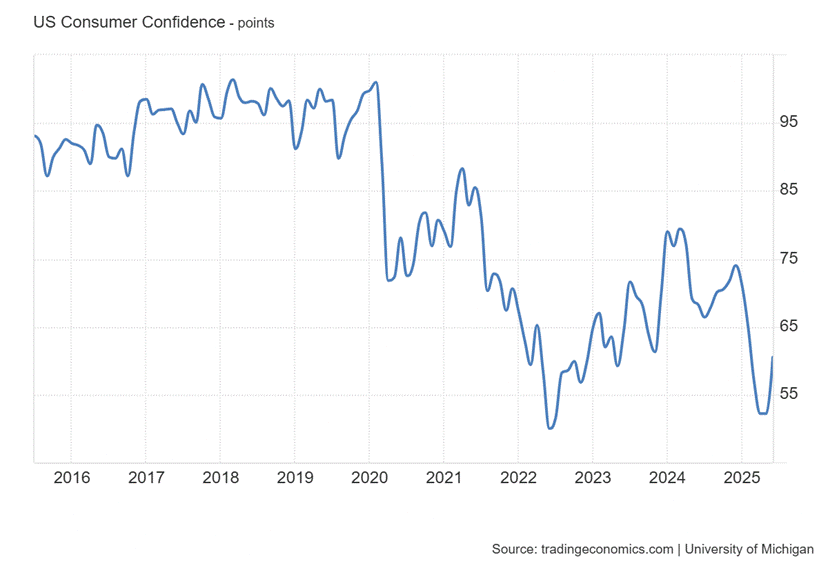
Consumer sentiment unexpectedly improved from where it was. The latest Michigan Consumer Sentiment Index came in at 60.5, well above last month’s nearly record low of 52.2 and above the expected 53.5. Seems they are less concerned about tariffs than previously. Maybe they are settling down from the shock. Nonetheless, the figure remains below the December 2024 level of 74.0 when it seemed to get a post-election bounce.
Keep in mind, though, that this is not the final for June. That isn’t due until the last week of June. Even inflation expectations fell, but that was before Israel decided to bomb Iran. Still, inflation expectations remain above the end of 2024 and below the immediate post-election bump for Trump.
Update
Oil

Nothing like a little war in the Middle East involving Israel and Iran to spark oil prices this past week. Is this our Black Swan event? The result was that WTI oil hit its highest level since December 2024 and the largest rise in three years. Not only have we filled the gaps but we also gapped higher (breakaway gap?). We appear to be on the cusp of breaking out above the downtrend line from the 2022 high set at the start of the Russia/Ukraine war.
We suppose if there is any bit of good news, it’s that WTI oil has quickly become overbought with an RSI at 78. However, that is also not necessarily a sign we’ll have a setback. Any easing of tensions could see oil fall back almost as swiftly as it rose.
On the week, WTI oil rose 13.6%, while Brent crude was up 12.2%. Natural gas (NG) was mixed as NG at the Henry Hub fell 4.5% while NG at the EU Dutch Hub rose 2.8% primarily because of the outbreak of the Israel/Iran war. Energy stocks benefitted as the Arca Oil & Gas Index (XOI) rose 7.3% while the TSX Energy Index (TEN) was up 7.4%.
Nonetheless, the focus was on Iran, the world’s seventh largest oil producer and holder of the world’s fourth largest reserves. It doesn’t stop there as Iran is the world’s third largest producer of natural gas and holds the world’s second largest reserves, behind Russia. While the U.S., Canada, and Saudi Arabia in particular are large producers of oil and NG, as well as holding the large reserves, the biggest producers and reserves include not just Iran and Russia but also Venezuela—countries the West has been in conflict with.
As well, Iran sits on the edge of the Straits of Hormuz where between 20% to 30% of the world’s oil passes through. Any attempt to disrupt the Straits or block them would immediately bring the U.S. into the war.
If the war remains at current levels, then a rise in oil prices to $80–90 per barrel is very possible. But after that it gets worse. Involve any attacks on the U.S. military or Gulf infrastructure and a rise to over $100 is not out of the question. The worst outcome is for a blockage, temporary or otherwise, to the Straits of Hormuz, and then a rise to $150 might not be out of the question. Bring more players into this conflict and then it could get even worse.
A reminder that Russia and Iran have a pact that includes defense. Russia, China and North Korea are major suppliers of weapons to Iran. China also imports Iranian oil of upward to 2 million bpd. Any disruption of the oil flow could bring China into the conflict.
The attack on Iran, plus the retaliatory attack on Israel by Iran, sent oil prices soaring, gold soaring, and stocks tumbling. The U.S. dollar also jumped sharply. Rising oil prices are also ultimately inflationary (particularly at the gas pump). As well, the conflict could spark more supply disruptions (also inflationary) in a world that already has significant supply disruption.
The U.S. has threatened to unleash attacks on Iran if they involve bombing of any U.S. bases in the Middle East and if they don’t sign the nuclear agreement where talks fell apart. U.S. involvement is already present as the U.S. may have provided strategic information to Israel for the attack and the U.S. is also involved in helping take down incoming Iranian drones and missiles. Israel launched their attacks against Iran from U.S. bases in the Mid-East. If the U.S. becomes involved, then other players are bound to come on board as well, leading to a much broader conflict. None of it is a good scenario.
S&P 500

Is this it? The top is in? In a world of rising geopolitical tensions, rising domestic tensions, conflicts with the government, and growing economic uncertainty because of tariffs, that is sparking probable inflation and rising unemployment. The G7 meets on June 15–17, but will anything come of it? The Fed also meets this week on June 17–18 and, given the inflationary pressures that still remain, the odds of a rate cut are slim to none.
Stock markets reacted quite negatively to the Israeli attack on Iran. The Dow Jones Industrials (DJI) fell over 700 points on Friday or 1.8% as a response to the attack. The rather steep up trendline that had been in place following the so-called easing of trade tensions was also broken, adding to the sense we may have topped. Not only are we dealing with the Israel/Iran conflict, but also the potential for violence at protest demonstrations planned for all across the U.S. against the actions of the Trump administration.
On the week, the S&P 500 fell 0.4%, the DJI dropped 1.3% as did the Dow Jones Transportations (DJT), while the NASDAQ fell 0.6%. The losses were less, mainly because markets were trying to rise earlier before the fireworks on Friday. The S&P 400 (Mid) fell 1.5% while the S&P 600 (Small) dropped 1.4%. The S&P 500 Equal Weight Index fell 0.8% while the NY FANG Index was off 0.7% after making new all-time highs. Bitcoin fell along with everyone else on Friday, but managed a 0.7% gain for the week.
Spared was Canada as the TSX Composite rose 0.3%, thanks to the strong materials sector. It didn’t quite spare the TSX Venture Exchange (CDNX) as it fell just under 0.1%. The EU didn’t fare well as the London FTSE was up a tiny 0.1%, but elsewhere it was losses as the EuroNext was down 1.2%, the Paris CAC 40 was off 1.5%, and the German DAX dropped 3.2%. Asia was mixed with China’s Shanghai Index (SSEC) off about 0.3%, the Tokyo Nikkei Dow (TKN) up about 0.3%, and Hong Kong’s Hang Seng (HSI) up 0.4%.
We are not sure that the stock markets are going to be too safe going forward. Even Trump’s Big, Beautiful Bill is in trouble in the Senate. But that’s not the big concern as signs continue that the labour market is softening (weekly claims were 248,000, the same as the previous week and pretty well on expectations) and inflation is ticking up. Trade tensions still abound and don’t expect anything out of the G7 this week. Trump’s attacks on Fed Chair Jerome Powell continue. But the big danger is war escalating in the Middle East. That conflict even creates a big wild card for Powell. Rising oil prices? Cutting rates will become impossible, despite Trump’s demands.
A top is confirmed under 5,750. Under 5,600 the market becomes more dangerous. It’s further away right now but under 5,200 new lows are probable. Yes, we did have the suggestion that we could make new all-time highs, but the action on Friday has dampened those expectations. Only new highs above 6,060 keep the hopes alive for new all-time highs.
We live in dangerous times and things appear headed for even more conflict and danger. Global warming is heating up the planet. However, conflicts both geopolitical and domestic are heating dangers to investors up even more. The safe haven remains gold.
The Scorecard

Thanks to the goings-on in the Middle East, gold has now extended its lead since Inauguration Day on January 20, 2025. Add in the growing protests in the U.S., along with threats of violence. However, the real surge this week belonged to WTI oil. While still down 5.1% since January 20, it’s now well off its lows down nearly 25%. Could it soon be positive? Stock markets are fading as all turned down this past week. The US$ Index continued its slide and it now leads the pack down, off 10.2% since January 20.
Gold

Gold, the ultimate safe haven. The Iranian attack by Israel, growing tension and potential for violence in the U.S. over the conduct of the Trump administration, and growing loss of faith in government has gold, the ultimate safe haven, rising again. No, not Bitcoin as Bitcoin actually fell on the outset of the attacks against Iran.
And it is not just the geopolitical tensions that are sparking gold as signs continue to suggest that central banks are still adding to their gold reserves, above what is being reported. Gold rose 3.7% this past week and is now just shy of new highs over $3,500 closing at $3,431. New highs could come early this week as the global and domestic situations worsen. Silver underperformed, rising only about 1%, but still made fresh 52-week highs. Platinum too made 52-week highs even as it faded on Friday rather than joining the gold rush.
Platinum was up 3.1% on the week. The near precious metals didn’t fare as well as palladium fell 2.3% and copper was off 1.3%. But the gold stocks responded with the Gold Bugs Index (HUI) up 3.0% and the TSX Gold Index (TGD) gaining 4.6%. New 52-week highs also beckon for the gold stocks.
We note that gold’s RSI is only at 62, so it has room to rise before going over 70 into overbought levels. As noted, new highs are highly probable this coming week. Once new highs are made, we have potential targets up to $3,900. For silver, we are targeting up to $44. No, they won’t reach those levels overnight nor will it necessarily be a straight-up move. But, given all the tensions, gold remains the ultimate safe haven.
Markets & Trends
| % Gains (Losses) Trends | ||||||||
| Close Dec 31/24 | Close Jun 13/25 | Week | YTD | Daily (Short Term) | Weekly (Intermediate) | Monthly (Long Term) | ||
| ne | ||||||||
| S&P 500 | 5,881.63 | 5,976.67 | (0.4)% | 1.6% | up | up | up | |
| Dow Jones Industrials | 42,544.22 | 42,197.79 | (1.3)% | (0.8)% | up | neutral | up | |
| Dow Jones Transport | 16,030.66 | 14,685.56 | (1.3)% | (7.6)% | up | down | neutral | |
| NASDAQ | 19,310.79 | 19,406.83 | (0.6)% | 0.5% | up | up | up | |
| S&P/TSX Composite | 24,796.40 | 26,504.35 (new highs) * | 0.3% | 7.2% | up | up | up | |
| S&P/TSX Venture (CDNX) | 597.87 | 721.13 (new highs) | (0.1)% | 20.6% | up | up | up | |
| S&P 600 (small) | 1,408.17 | 1,294.07 | (1.4)% | (8.1)% | up | down (weak) | neutral | |
| MSCI World | 2,304.50 | 2,651.57 (new highs) * | (0.2)% | 15.1% | up | up | up | |
| Bitcoin | 93,467.13 | 105,124.13 | 0.7% | 12.5% | neutral | up | up | |
| Gold Mining Stock Indices | ||||||||
| Gold Bugs Index (HUI) | 275.58 | 431.81 | 3.0% | 56.7% | up | up | up | |
| TSX Gold Index (TGD) | 336.87 | 512.48 | 4.6% | 52.1% | up | up | up | |
| % | ||||||||
| U.S. 10-Year Treasury Bond yield | 4.58% | 4.41% | (2.2)% | (3.7)% | ||||
| Cdn. 10-Year Bond CGB yield | 3.25% | 3.38% | 1.2% | 4.0% | ||||
| Recession Watch Spreads | ||||||||
| U.S. 2-year 10-year Treasury spread | 0.33% | 0.45% | (2.2)% | 36.4% | ||||
| Cdn 2-year 10-year CGB spread | 0.30% | 0.66% | 3.1% | 120.0% | ||||
| Currencies | ||||||||
| US$ Index | 108.44 | 98.21 | (1.0)% | (9.4)% | down | down | down | |
| Canadian $ | 69.49 | 0.7360 | 0.8% | 5.9% | up | up | down | |
| Euro | 103.54 | 115.40 (new highs) | 1.3% | 11.5% | up | up | up | |
| Swiss Franc | 110.16 | 123.24 | 1.3% | 11.9% | up | up | up | |
| British Pound | 125.11 | 135.62 | 0.2% | 8.4% | up | up | up | |
| Japanese Yen | 63.57 | 69.42 | 0.5% | 9.2% | up | up | neutral | |
| Precious Metals | ||||||||
| Gold | 2,641.00 | 3,431.96 | 3.7% | 30.0% | up | up | up | |
| Silver | 29.24 | 36.28 (new highs) | 1.0% | 24.1% | up | up | up | |
| Platinum | 910.50 | 1,207.90 (new highs) | 3.1% | 32.7% | up | up | up | |
| Base Metals | ||||||||
| Palladium | 909.80 | 1,025.50 | (2.3)% | 12.7% | up | up | down | |
| Copper | 4.03 | 4.74 | (1.3)% | 17.6% | up | up | up | |
| Energy | ||||||||
| WTI Oil | 71.72 | 73.42 | 13.6% | 2.4% | up | up (weak) | down | |
| Nat Gas | 3.63 | 3.60 | (4.5)% | (0.8) | up | up | neutral | |
__
(Featured image by Veli Yunus Unal via Unsplash)
DISCLAIMER: This article was written by a third party contributor and does not reflect the opinion of Born2Invest, its management, staff or its associates. Please review our disclaimer for more information.
This article may include forward-looking statements. These forward-looking statements generally are identified by the words “believe,” “project,” “estimate,” “become,” “plan,” “will,” and similar expressions, including with regards to potential earnings in the Empire Flippers affiliate program. These forward-looking statements involve known and unknown risks as well as uncertainties, including those discussed in the following cautionary statements and elsewhere in this article and on this site. Although the Company may believe that its expectations are based on reasonable assumptions, the actual results that the Company may achieve may differ materially from any forward-looking statements, which reflect the opinions of the management of the Company only as of the date hereof. Additionally, please make sure to read these important disclosures.
David Chapman is not a registered advisory service and is not an exempt market dealer (EMD) nor a licensed financial advisor. He does not and cannot give individualised market advice. David Chapman has worked in the financial industry for over 40 years including large financial corporations, banks, and investment dealers. The information in this newsletter is intended only for informational and educational purposes. It should not be construed as an offer, a solicitation of an offer or sale of any security. Every effort is made to provide accurate and complete information.
However, we cannot guarantee that there will be no errors. We make no claims, promises or guarantees about the accuracy, completeness, or adequacy of the contents of this commentary and expressly disclaim liability for errors and omissions in the contents of this commentary. David Chapman will always use his best efforts to ensure the accuracy and timeliness of all information. The reader assumes all risk when trading in securities and David Chapman advises consulting a licensed professional financial advisor or portfolio manager such as Enriched Investing Incorporated before proceeding with any trade or idea presented in this newsletter.
David Chapman may own shares in companies mentioned in this newsletter. Before making an investment, prospective investors should review each security’s offering documents which summarize the objectives, fees, expenses and associated risks. David Chapman shares his ideas and opinions for informational and educational purposes only and expects the reader to perform due diligence before considering a position in any security. That includes consulting with your own licensed professional financial advisor such as Enriched Investing Incorporated. Performance is not guaranteed, values change frequently, and past performance may not be repeated.

-
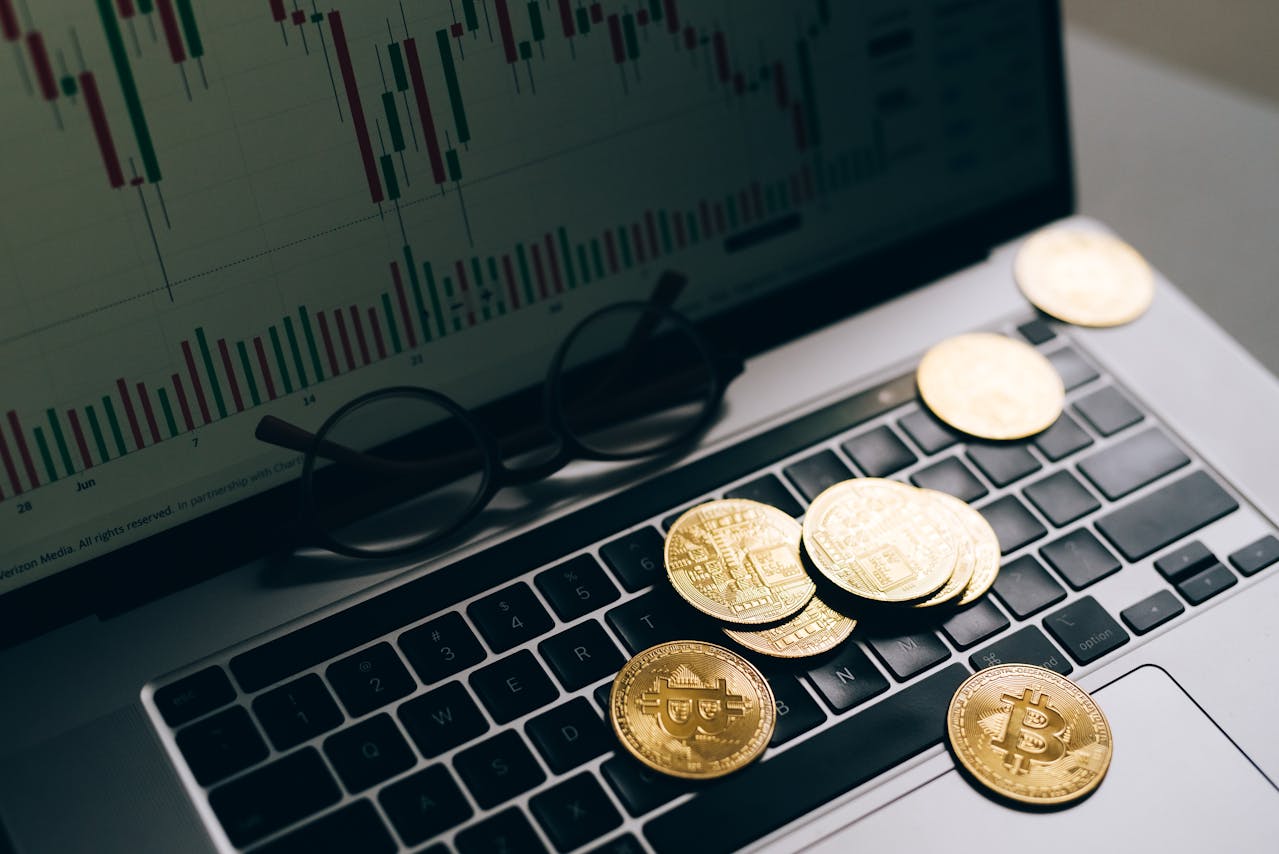
 Crypto2 weeks ago
Crypto2 weeks agoCrypto ETF Inflows Signal Renewed Market Confidence
-

 Crowdfunding1 day ago
Crowdfunding1 day agoDeep Learning Italia Launches €400K Crowdfunding to Bridge Italy’s Tech Skills Gap
-

 Biotech1 week ago
Biotech1 week agoSpain Joins First EU Joint Clinical Assessment Under New Health Technology Regulation
-

 Crowdfunding5 days ago
Crowdfunding5 days agoa2censo Expands Crowdfunding Access for SMEs and New Investors




